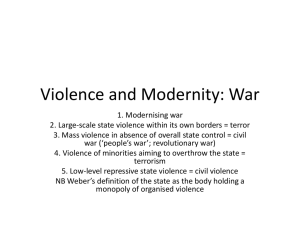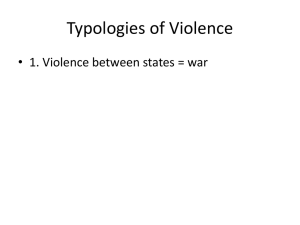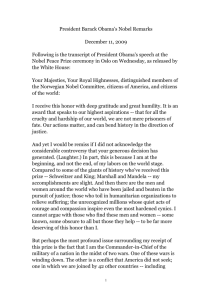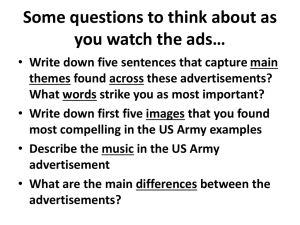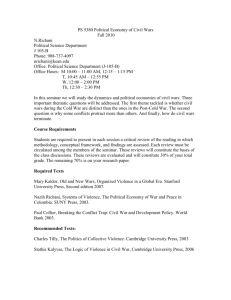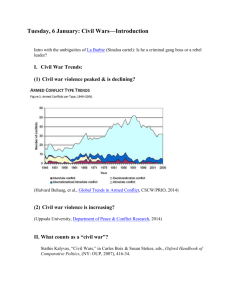Violence and Modernity: War
advertisement
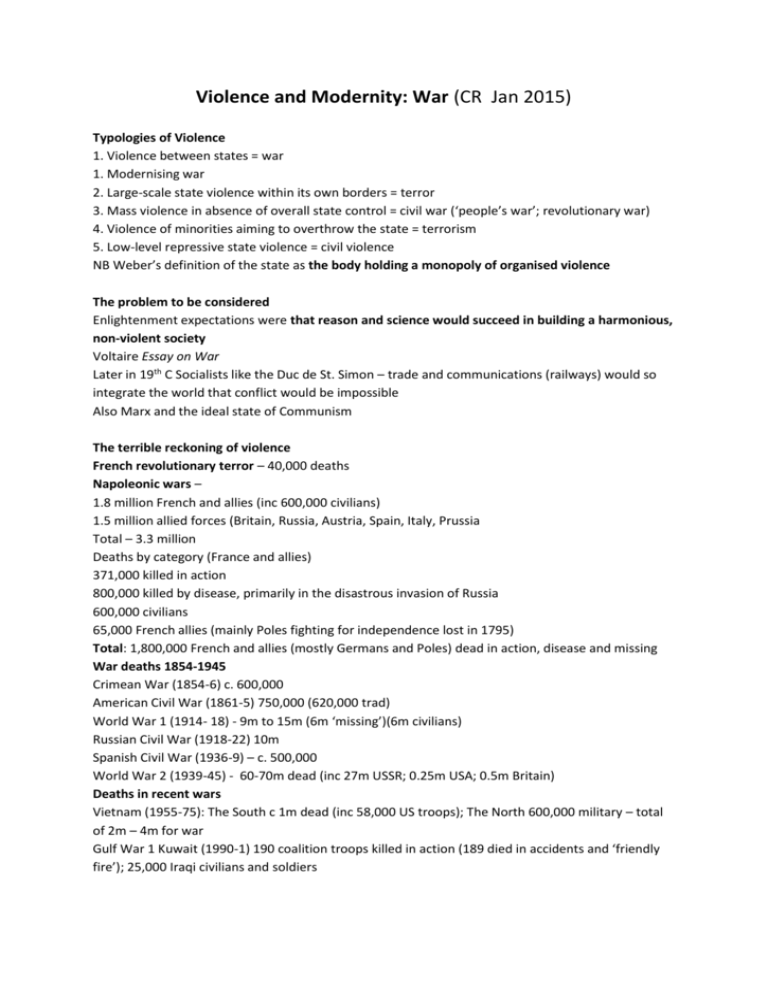
Violence and Modernity: War (CR Jan 2015) Typologies of Violence 1. Violence between states = war 1. Modernising war 2. Large-scale state violence within its own borders = terror 3. Mass violence in absence of overall state control = civil war (‘people’s war’; revolutionary war) 4. Violence of minorities aiming to overthrow the state = terrorism 5. Low-level repressive state violence = civil violence NB Weber’s definition of the state as the body holding a monopoly of organised violence The problem to be considered Enlightenment expectations were that reason and science would succeed in building a harmonious, non-violent society Voltaire Essay on War Later in 19th C Socialists like the Duc de St. Simon – trade and communications (railways) would so integrate the world that conflict would be impossible Also Marx and the ideal state of Communism The terrible reckoning of violence French revolutionary terror – 40,000 deaths Napoleonic wars – 1.8 million French and allies (inc 600,000 civilians) 1.5 million allied forces (Britain, Russia, Austria, Spain, Italy, Prussia Total – 3.3 million Deaths by category (France and allies) 371,000 killed in action 800,000 killed by disease, primarily in the disastrous invasion of Russia 600,000 civilians 65,000 French allies (mainly Poles fighting for independence lost in 1795) Total: 1,800,000 French and allies (mostly Germans and Poles) dead in action, disease and missing War deaths 1854-1945 Crimean War (1854-6) c. 600,000 American Civil War (1861-5) 750,000 (620,000 trad) World War 1 (1914- 18) - 9m to 15m (6m ‘missing’)(6m civilians) Russian Civil War (1918-22) 10m Spanish Civil War (1936-9) – c. 500,000 World War 2 (1939-45) - 60-70m dead (inc 27m USSR; 0.25m USA; 0.5m Britain) Deaths in recent wars Vietnam (1955-75): The South c 1m dead (inc 58,000 US troops); The North 600,000 military – total of 2m – 4m for war Gulf War 1 Kuwait (1990-1) 190 coalition troops killed in action (189 died in accidents and ‘friendly fire’); 25,000 Iraqi civilians and soldiers Gulf War 2 – Iraq (March-May 2003) 172 coalition troops killed c.200,000 involved – 30,000 Iraqi troops and civilians killed) Afghan Wars – 1979-8 (15,000 Soviet military: 75,000 plus Mujaheddin; maybe ) 0.6 to 1.0m civilians - 2001- ?? (3,162 coalition dead; 15,000 civilians; Taliban – unknown) Why have wars expanded? 1. Technology – weapons derived from industry 2. Logistics – organisation - An army ‘marches on its stomach’ – Napoleon 3. Soldiers – recruitment, conscription, motivation (rise of nationalism/ nation state) 4. Money = ever-larger tax revenues 2 + 3 + 4 = modern state – prerequisite for mass warfare (+ ideology esp. Nationalism) Military revolution - technology 1750 – muskets (accuracy 100/150 yards; 5 rounds per minute) - Cannon – shot and some crude shells = wars of mobility (cavalry) and close quarters fighting - bayonets, swords, daggers Begins to change in early 19th C C 1850 – rifle (rifling in barrel) increases accuracy to 500 yards. Bullet magazines and rapid re-loading increase frequency of firing. 1870 true rifle. 1862 Gatling gun – hand-cranked machine gun; Maxim gun – automatic – 100s of rounds per minute Second half of nineteenth century Dynamite and high explosive (chemical industry) Internal combustion engine railways Steel - e.g. armour plating of ships Leads to - dreadnoughts at sea long range artillery (20 miles by WW1) high-explosive shell. Obliterate anything exposed so Warfare becomes defensive – trenches (American CW and Russo-Japanese War as prototypes of First World War) (mortars 100-300 yds define distance of trenches) Military revolution - technology From WW1 to WW2 Aircraft – airships (derived from hot-air balloons) – failure cf gas - biplanes/triplanes – spotting; bombing; dogfights (NB first flight – 17 Dec 1903 – 120 ft; 12 seconds (7 mph) alt 10 ft.) Tanks (diesel engines)– to break through trenches Blitzkrieg (lightning war) = blitzkrieg – massive concentration of power at a small point – punch hole in defence – pour through using mobile infantry, spread out and attack from behind Blitzkrieg – Volkhov Jan 1942 Mass bombing Guernica 1937 c. 1000; Coventry 1940 c. 1000 in two raids; Dresden (Feb 1945) c. 25,000; Tokyo (1945) 75,000 +; Nuclear bombs - Hiroshima and Nagasaki (Aug 1945) 100,00 each Military revolution - technology 1945 a kind of apogee – military development bifurcates: 1. The hi-tech path continues producing weapons that, in many cases, can scarcely be used World War 2 and beyond (Cold War) Rockets – Katiushas; V1; V2 – missiles – ICBMs - mirv Jet engines Computers and communications (12 signals exchanged at Trafalgar: 50,000 per hour in Gulf War 1) Cruise missiles; Drones 2. ‘Asymmetric warfare’- ‘People’s War’ Up to 1945 – size matters – the wealthiest and best equipped win. But ‘conventional’ war is increasingly challenged Post-1945 in anti-colonial and anti-imperialist wars small forces have sometimes prevailed over or counter-balanced the most advanced equipment Guerilla and Revolutionary wars (‘People’s Wars) – China; Cuba; Latin America; Kenya; Malaya Vietnam war – ‘bicycles versus B-52 bombers’ Current wars in Middle East Other components of military revolution 2. Logistics – organisation 3. Soldiers – recruitment, conscription 4. Money = ever-larger tax revenues 2 + 3 + 4 = modern state – prerequisite for mass warfare (+ ideology esp. Nationalism) Logistics and organisation In a modern army only around ten percent are frontline troops – the rest organise, plan, maintain, transport etc. Requires a major bureaucracy to sustain it with endless skills, technical, practical and managerial Recruitment In 18th c – volunteers, mercenaries, press-gangs Napoleon institutes first nationwide conscription – Levee en masse - originates in 1793 with CPS as a mass call to arms and defence (embryonic total war – men called to fight, women to work in factories – linked to emergence of citizenship) - institutionalised from 1797 on Money United States Federal, State and Local Government Spending (see ppt on website) http://www.youtube.com/watch?v=1cIjTodmfk0Slide 49 http://www.youtube.com/watch?feature=endscreen&v=slaNADrdPMA&NR=1 http://www.youtube.com/watch?v=TKtCVblxDRc&feature=endscreen&NR=1 http://www.youtube.com/watch?v=msHJLwYWX30 http://www.youtube.com/watch?v=20JCGDwBt7A Violence and Modernity: War 2. Social costs and scars of war As we have already seen the costs, scars and consequences of war are inseparable from its other aspects. We have been looking, for example at its interaction with the modern state. War is at the core of modern citizenship and the developing ideologies – especially nationalism – are geared to uniting people to fight. War is a, arguably the, main raison d’etre of the modern state. Impacts associated with war economic development; Technological, medical and scientific development; Cultural/psychological impact; Political manipulation; Social change (gender roles; weakens class); Engenders revolutions; Destroys empires and economies [NB War rarely ‘solves’ political and international problems it sets out to combat – instead, it usually displaces them with other, often more acute, problems.] Impacts 1 Economic Development Victory can strengthen a country’s economic grip by defeating a rival – classic example is Britain vs France Seven Years’ War and beyond. Imperialism and imperial state – Hobson, Lenin, Hilferding et al. War makes state a leading investor and/or customer - War (and space) spending has a ‘Keynesian’ effect on economy -‘Military-industrial complex, Impacts 2 Technological, medical and scientific development Impacts 3 Cultural/psychological impact Enormous impact of war on culture high and low Goya and war painting from Napoleonic period From figurative to abstract art – music Tchaikovsky to Stravinsky; Painting - Kandinsky War Movies http://www.youtube.com/watch?v=Gz3Cc7wlfkI Impacts 4 Political Manipulation Chauvinistic military campaigns to influence elections (Falklands factor) French imperialism in N.Africa Bismarck Impacts 5 Social Change gender roles; in mass warfare women move into ‘male’ civilian roles at work (what happens when the surviving men come back?) weakens class – ‘all in it together’ welfare state Impacts 6 Engenders Revolutions Russian Revolution Chinese Revolution – People’s Liberation Army, Long March, Yunan Period Impacts 7 Destroys Empires 1914 map/1919 map

